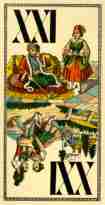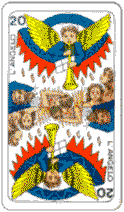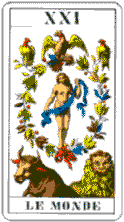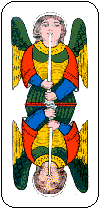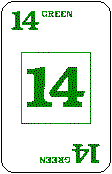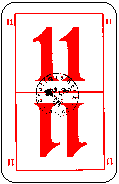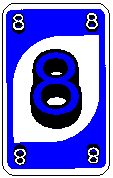Classified Index of Card Games
- Introduction
- Browse Classification Network
- Mechanism
- Objective
- Number of players
- Equipment (type of cards, dominoes or other tiles)
- Country or region
- Theme
- Children's Games
- Other Classifications
Introduction
There are many different ways to classify card games, none of them entirely satisfactory. An excellent discussion of the difficulties can be found in David Parlett: The Oxford Guide to Card Games (Oxford University Press 1990) pages 61 to 64. Because traditional card games tend to evolve gradually, through a series of modifications and improvements, it is tempting to try to develop a taxonomy analogous to those of animals and plants, in which the evolutionary process can be represented by a family tree. This does not work so well for games, because in many cases games evolve by absorbing ideas from other games of different types.
Nevertheless there are several reasons to attempt to organise the thousands of different card games that exists into classes of games that have something in common. One is to make it possible to search for a game with certain characteristics, without necessarily knowing what it is called. Another is to help in the study of the history of games, by finding common elements that may indicate that one games has been derived from or influenced by another. A third is the practical motive of finding a suitable game to be played by a particular set of people, or using a particular kind of cards that happen to be available.
Following Parlett, the main classification used to organise games on this web site is by mechanism: games are categorised according to the process for playing them - i.e. what you do when it is your turn to play. Another type of classification is by objective, based on what the players have to do in order to win. Some games employ more than one mechanism and have more than one objective, so when one tries to represent the relationships between games and classes as a diagram, the result is not a tree but a rather complex network in which games may belong to several overlapping or intersecting classes.
On this website I have also provided several other classifications that may be helpful. As well as an alphabetical index by name there are indexes of games by numbers of players and by the countries or regions where they are played. The indexes by name and by number of players also indicate the type of cards or tiles used. I have included a section on classification by theme though this is generally more suited to proprietary games played with special card decks or tile sets, most traditional card games being abstract in nature. I have also tried to put together a list of children's card games, though opinions on what games are suitable for children may differ widely. Finally there is a discussion of other types of classification that might be added in future.
Classification Network Browser
The network browser has been provided for those who would like to see the classification used on pagat.com by game mechanism and objective set out as a diagram. This is a work in progress. Since the full diagram is very complex and hard to read, the browser allows the user to navigate around the network viewing a neighbourhood of a selected node. At present it includes mostly traditional games, though some items from the invented games section have been included where they naturally fit into existing categories. Apart from mechanisms and objectives, a few other groupings such as domino games and solitaire games have been included.
Games Classified by Mechanism
The aim in this classification is to put together games which have similar mechanics of play. As card games evolve and change, players tend to keep the basic mechanism of a game they know, but vary the objectives or some of the details. Sometimes complications are added to make the game richer; sometimes games are simplified to speed them up, and sometimes ideas are introduced by analogy with other games. A result is that in this classification games that are historically related, being derived from each other or having a common ancestor, tend to end up together in the same group.
I use just five main categories: outplay, exchange, comparison, layout and other. These categories are subdivided into groups and subgroups. Some of the subgroup divisions may take into account the objectives of the game as well as the mechanism. This classification scheme seems to be working reasonably well - nearly all the traditional games being added to the site can be fitted into one of the existing groups. From time to time further groups of related games have been identified and added.
Outplay Games
This is by far the largest main category. Each player has a hand of cards and a move consists of playing out one or more cards to the table to achieve some effect. The play ends when some or all of the players have run out of cards to play.
- Trick Taking Games A trick consists of each player in turn playing one card face up to the table. There are Plain Trick Games in which only the tricks themselves are important, and Point Trick Games in which the value of tricks is affected by which cards they contain. Inflation games are similar to trick-taking games, but players may acquire extra cards during the game, making the hand sizes unequal.
- Beating Games At your turn you must either beat the card played by the previous player or pick it up (possibly with other cards) and add it to your hand. The aim is generally to get rid of all your cards.
- Climbing Games In these games if you cannot or do not wish to beat the previous play you simply pass.
- Adding Games The cards are played in a pile and their values added, the aim usually being to achieve or avoid particular totals.
- Fishing Games There is a pool of face-up cards on the table which can be captured by playing a matching card from your hand.
- Matching Games At your turn you must play a card which matches the previous play or fits into a layout according to some rule. Most often the aim is to get rid of all your cards in this way. This category includes the stops group, the eights group and connecting games of the layout group.
- War Group Players store their cards in a pile face down and turn up the top card to play it. In certain circumstances the played cards are captured by one player, and added to their store of cards.
Card Exchange Games
Each player has a hand of cards and a move consists of exchanging a card or cards. The exchange may be with another player or with a stock of face-up or face-down cards on the table. The objective is generally to collect certain cards or combinations of cards.
- Draw and Discard Games The basic move is to draw a card from the stock and discard one to the discard pile. This category includes the large group of Rummy Games.
- Commerce group There is a common pool of cards on the table, and at your turn you exchange one or more cards with the pool.
- Cuckoo group Each player has only one card, and at their turn can try to exchange this for their neighbour's card.
- Quartet group At your turn you can ask another player for a card that you want, and if they have it they must give it to you.
- Card passing games A move consists of passing a card or cards to your neighbour, or in some cases taking a card from your neighbour.
Hand Comparison Games
In these games there is little or no actual play of cards. The result is determined simply by comparing the cards dealt to the players to see which is best, or sometimes simply on the turn of a card or cards to decide whether a player wins or loses. In some games there may be an opportunity to improve your position by drawing some extra cards, or by choosing how to arrange your cards into groups. There are many gambling games in this category, often with elaborate betting procedures.
- Showdown Games In these games the players' hands are compared with each other and the player with the best hand wins (or the one with the worst hand loses). In Partition Games, the players divide their hand into parts, which are compared separately.
- Vying games In these games, before the hands are compared, players may propose to raise the stakes, and those who do not wish to accept the raise may drop out.
- Banking games The players do not play against each other, but each plays individually against a special player - the banker.
Layout Games
These are games involving a layout of cards on the table, following rules about which cards can be played or moved to which positions.
- Single player patience (solitaire) Patience games were originally designed for a single player. Cards are moved around a layout, normally with the objective of sorting the pack, for example by playing all the cards to in suit and rank order 'foundation piles'. The player wins if the sorting is successful (the patience comes out), and loses if a position is reached from which the cards cannot be sorted.
- Competitive patience Several players compete to be the first to complete a patience-like game, either using a common layout or each having their own layout and sharing the foundation piles.
- Connecting games Cards are played from hand to a layout in accordance with restrictions as to which cards fit where, sometimes with the aim of getting rid of all one's cards and sometimes to form scoring combinations in the layout. These can also be seen as a type of outplay game. Many domino games work this way.
Other Games
This category is for games that do not yet fit into the above classification.
- Combat games Each player has a fighting force represented by cards and a move can be used to attack another player's force. Since killed cards are discarded and forces can be replenished, these might perhaps be classified as card passing games akin to the draw and discard group.
- Compendium games Games which use two or more different kinds of play mechanism in succession or as alternatives.
- Race games Games in which cards are used to move tokens or other cards along a race track.
- Role Games Cards are used to assign secret identities to the players.
- Miscellaneous games Games whose mechanisms do not belong to any of the other groups.
Games Classified by Objective
This second classification is according to what you need to do in order to win the game.
- Capturing cards
- These are games in which the aim centres around capturing cards or avoiding capturing cards. It may be the sheer quantity of cards captured that is important, or it may be that some cards are more valuable than others.
- Shedding or accumulating cards
- These are games in which the objective is either to get rid of or to acquire cards.
- Forming combinations of cards
- In these games you win, or score points, by combining cards in various ways.
- Comparing cards
- These are relatively simple games in which winning or losing depends on comparing one card with another.
- Other objectives
- Every classification needs an "other" category - in this case to accommodate games whose objectives are different from any of the above.
Games classified by type of cards or tiles used
This classification is intended to help people who have some cards of a particular design and want to find out what games they are used for.
French Suited Cards Four suits: hearts, diamonds, clubs and spades. Each suit usually has three picture cards (king, queen, jack) plus numeral cards from 1 (ace) to 10 (some packs have fewer or more numerals per suit). One, two or more jokers may be included. Some games use multiple packs.
German Suited Cards Four suits: acorns, leaves, hearts and (spherical) bells. Each suit has three picture cards, generally all male, an ace or deuce, and some numeral cards, which often run from 10 down to 7 or 6. Some games use a double pack.
Latin Suited Cards Four suits: swords, batons, cups and coins. Each suit has three picture cards, generally a king, a knight on horseback and a jack or maid. Numeral cards run from 1 (ace) to 7 or 9 or occasionally 10.
Swiss Suited Cards Four suits: acorns, flowers (roses), shields, and (spherical) bells. Each suit has three picture cards (king, over and under), a banner, an ace or deuce, and some numeral cards - usually 9, 8, 7, 6, sometimes 9's only, and sometimes from 9 down to 3. Some games use a double pack.
French Suited Tarot Cards Four suits: hearts, diamonds, clubs and spades. Each suit has four picture cards (king, queen, cavalier, jack) and up to 10 numeral cards. In addition there are 21 trump cards with large roman or arabic numbers and various illustrations, and the fool, which has no number or suit, but often depicts a jester or musician.
Italian Suited Tarot Cards Four suits: swords, batons, cups and coins. Each suit has four picture cards (king, queen, cavalier, jack) and up to 10 numeral cards. In addition there are trump cards - usually 21 of them - with traditional illustrations such as sun, wheel of fortune, death, chariot, plus a card depicting a fool.
Domino Tiles or Cards Each tile has a number of spots at each end, usually arranged like the spots on a die. Usually all combinations of two numbers from 0 or 1 up to 6, 9, 12 or 15 are present. The card version has a representation of a domino at each end.
Money Cards or Tiles These oriental cards are usually long and narrow and have three or four suits, which originally corresponded to denominations of money - cash, strings of a hundred cash, tens of thousands, and so on. Each suit generally has numerals from 1 to 9 and there may be some additional special cards. Mah Jong tiles or cards also belong to this type.
Chess Cards The ranks of these cards correspond to the pieces in Chinese Chess (Xiangqi), and each rank is present in either two or four colours. Some packs have additional cards.
Flower Cards These cards, used in Japan, Korea and Hawaii, have four cards for each month of the year, each month corresponding to a different flower or plant.
Indian Circular Cards There are usually eight or twelve suits, each with two picture cards and ten numerals.
Number Cards or Tiles There are several types of cards which have numbers rather than repeated suit marks to represent ranks. As there are no suitmarks, the different suits are generally replaced by different colours or different styles of numeral.
Single Suited Cards There is a sequence of cards, the ranks being represented by numbers or pictures, with no distinction between suits (or colours). Often there are two (identical) cards of each rank.
Other Types of Cards or Tiles There are many cards, especially those made for proprietary or commercial games, which do not fall into any of the above types.
Classification by Theme
Although many proprietary card and board games are based on themes from the outside world, most traditional card and board games are abstract in nature. There are a few exceptions, and quite a few themed card games have been invented that use standard cards.
The Sport Simulation Games page has a small selection of games with standard cards - mostly recently invented but also some with a longer tradition.
Combat Games can be said to be based on a theme of battles between opposing forces, quite often with various magical powers, and although most use proprietary themed decks, there are also many that can be played with standard playing-cards.
Role Games might also be regarded as themed games, representing something like an investigation to find the identity of a suspect. Also Race Games clearly represent races, though the race of pegs or cards may appear quite abstract.
One type of themed card game that has quite a long tradition is Top Trumps. Special cards for this game based on a variety of themes are are available from several manufacturers.
Children's Games
Several people have asked me to recommend card games suitable for children. This is difficult because children vary so widely in their interest and ability at card games. Here is a list of games generally considered as children's games or which have been recommended to me a suitable for children. No doubt readers will let me know if this is appropriate or wide of the mark.
24, Animals, Beggar My Neighbour, California Speed, Camicia, Card Bingo, Crazy Eights, Earl of Coventry, Fan Tan, German Whist, Go Fish, I Doubt It, James Bond, Kemps, Kings Corners, Knockout Whist, Mustamaija, Nerts, Old Maid, Pelmanism / Memory, Pig / Spoons, Ride the Bus / Scat, Slapjack, Snap, Snip Snap Snorum, Spit, Stealing Bundles, Trash, War, Zsírozás.
The above list consists mostly of games considered by adults as suitable for children, but of course many children delight in games that involve bad language, gambling or cheating. The attraction of these may be enhanced by the disapproval of adults. Games that children and young people sometimes prefer to play when left to themselves include: Cheat, President, Shithead, 52 Card Pickup (!) and various simple gambling games.
The above lists contain only games played with standard cards (from various countries) whose rules already happen to be on this web site. You can find many others in the usual card game books, and I will probably add more children's games to the web site when I have time. There are also many popular children's games which use special proprietary cards; a few of these can be found on the Commercial Games page.
Other Classifications
There is potential to classify card games in many other ways. Some of these may be objective, some largely subjective. Ideas for classification that have been suggested include:
- complexity of rules,
- luck / skill,
- how long the game takes to play
- ratings by readers
One classification that many people would like to have is into better games and worse games. A difficulty with this is that nearly every card game on this web site has come with a recommendation from the contributor that it is the best card game in the world. For many people the best card game to play is one that your friends and colleagues already know. A game tends to run much more smoothly and to be more fun to play a game when most players are already familiar with the rules and have some experience. To embark on playing an unfamiliar game armed only with a written set of rules takes a greater amount of dedication and patience. It can take a lot of playing time to discover the potential of a card game if you do not have an experienced player in the group to answer questions and point out possibilities.
Any good/bad classification is going to be mainly a reflection of personal preferences. A few people have asked me about my favourite games. Of the games I have tried I would recommend: Skat, Hungarian Tarokk, Scopone, Bridge, Schieber Jass. Further recommendations can be found in








